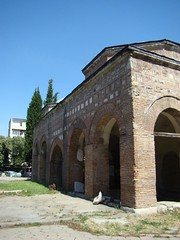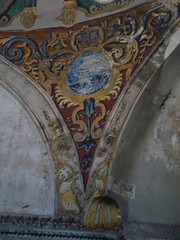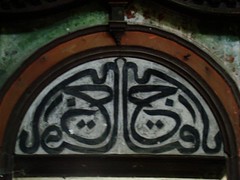 Normally as hidden treasures we understand something small, that was buried and hidden from invaders, thieves etc. In this case, the architectural and artistic treasure of the 600-year old mosque is hidden because of political reasons: the place is not “politically correct”.
Normally as hidden treasures we understand something small, that was buried and hidden from invaders, thieves etc. In this case, the architectural and artistic treasure of the 600-year old mosque is hidden because of political reasons: the place is not “politically correct”.
Situated in the dead center of Stara Zagora downtown, next to the biggest department store, only two blocs away from the City Hall and a block away from the Regional Museum of History, the prominent structure of the Old Mosque hardly qualifies as hidden. All of us who were born and raised in Stara Zagora had seen the mosque thousands of times. And yet, we didn’t know anything about it. Falling into ruins, it was just another old building.
The Eski Djamia
History
It was inaugurated in September 1409, as an inscription in the prayer’s vault tells us. That was the time of the Ottoman Interregnum, when the son of Bayazid I (“The Thunderbolt”), Suleyman Çelebi, or Emir Süleyman (b. 1377 – d. 17 February 1411) ruled over Thrace, Bulgaria and Greece. In that time, the capital of the Ottoman Empire was still in Edirne (Hadrianopolis, Thrace) and very close to Stara Zagora. Which explains the magnificent construction of the mosque.
Documents suggest that in spite of its name, the mosque was not the oldest mosque in the city – prior to it, there was another one, which is not discovered yet.
The mosque was built on a sacred place, occupied previously by a Thracian sanctuary (a heron) dedicated to the Thracian Horseman, the most prominent hero in the Thracian civilization. A Bulgarian Medieval Church from the 10thC. A.D. was discovered in the recent archaeological digs below the floor of the prayer salon of the mosque. The chu
rch was built following a simple architectural one-nave plan and the foundation of the church was 30 cm (1 foot) below the base of the mosque. Next to the church were discovered 30 graves, which suggests a Christian necropolis or burial ground for the noblest Christians of the city (then called Irinopolis) was situated there.
Below the eastern wall of the mosque was discovered a ritual pit from the Early Iron Age (1000 years BC). The ceramic kilns, discovered during the 2001-04 excavations, date from the 5th and 6th C. A.D. The long history of the sacred place, where the mosque is located, has layers of civilization from 1000 years before the common era to 19th century.
Between 2001 and 2004, the archaeologists discovered a stelae with Greek inscription from the times of the Roman Emperor Gallienus (Publius Licinius Egnatius Gallienus, c.218-268), which was covered by plaster around 1882, during the second major reconstruction of the mosque.
The Eski Djamia was mentioned in the travel memoirs of Evliya Çelebi, a famous Ottoman traveler from the 17th century (http://en. wikipedia.org/wiki/Evliya_%C3%87elebi.)
wikipedia.org/wiki/Evliya_%C3%87elebi.)
In modern day Stara Zagora, Eski Djamia is the only building to survive the burning of the city by the Turkish Army in the Russian-Turkish Liberation War. Francis Vinton Greene, in his book “The campaign in Bulgaria, 1877-1878” describes the atrocities of the Suleyman Pasha armies during the war: “Suleiman Pasha had already burned the large town of Eski- Zagra to the ground, and had begun in the valley of the Maritza a wholesale system of hanging at the street corners every Bulgarian who had assisted (as guide, etc.) Gourko's troops during their stay south of the Balkans.” Another writer explains why Stara Zagora is completely new city (in architecture): “The town is almost entirely new, as the old town was burnt by the bashi-bazooks, who made pyramids of the heads of the Christian inhabitants.” (The Living age by Eliakim Littell, Robert S. Littell – 1894).
Architecture
The building consists of a square prayer hall and open entrance, covered by three small domes. From the entrance, the visitor proceeds to a gallery on the northern side of the mosque from which follows the prayer hall. A cupola shaped dome with 20 sides covers the prayer hall. The minaret of the mosque existed until 1987, when it was destroyed on purpose because of danger of collapse. Three rows of windows - the ones on the cupola dome and two lines of windows on the walls, give natural light to the prayer hall.
From archaeological data it is known that the Eski Djamia went through several reconstructions and improvements during the Ottoman history of Stara Zagora (Eski Zagra was the Turkish name for the city).
The first big reconstruction of the mosque was performed in the middle of the 19th century, just after a fire, which destroyed the adjoined bazaar in 1856. During this reconstruction, the floor level was raised by about 30 centimeters and covered with square tiles.
The northern gallery dates from the same period, as well as the frescoes, which decorate the walls, the dome and the second row of windows.
The second big renovation and the re-sanctification of the mosque dates from 1882. During this reconstruction, the arched spaces were filled and two spaced were formed in the main building.
Thanks to the great architecture of the building, the Eski Djamia is declared as national monument of culture in 1927. In 1979 it is declared as national monument of architecture.
Wall paintings, frescoes and calligraphy
The majority of the wall paintings (frescoes and Islamic calligraphy) date from the first reconstruction in 1856. The picturesque baroque style and the elegance of the calligraphy are the reason behind declaring them separately as a national monument.
Importance
During the period immediately after the Liberation of Bulgaria from the Turkish Empire, many of the mosques and examples of Ottoman architecture and arts were destroyed. The reason was the anger and hatred of the Bulgarian people against 500 years of torture, genocide, and constant attempts for destruction of the Bulgarian nation by the oppressors. Eski Djamia was spared from this campaign, and now represents the only building remaining in Stara Zagora from the 15th
The artistic and architectural importance of the mosque are recognized by both scientists and governments. The recent archaeological discoveries are extremely valuable because they prove the continuance of the sacred place during several époques of the human history hidden below the building.
Current situation
Several plans for preservation and restoration of the mosque were carried out with different success during the past 30 years. The mosque is still in decay and under great danger of destroying the wall paintings and the interior structure. A recent plan for complete restoration of Eski Djamia was proposed, with the idea of that the place should become a “Museum of the Religions and Faiths”.  Unfortunately, the misinformed citizens of Stara Zagora strongly oppose the restoration of the mosque, fearing that it can become an active Mosque. Of course, this is not possible, viewing the status of the Eski Djamia as national monument of culture. Still this movement against the Islamic culture is an obstacle for financing and preserving the art and architecture of the mosque.
Unfortunately, the misinformed citizens of Stara Zagora strongly oppose the restoration of the mosque, fearing that it can become an active Mosque. Of course, this is not possible, viewing the status of the Eski Djamia as national monument of culture. Still this movement against the Islamic culture is an obstacle for financing and preserving the art and architecture of the mosque.
© 2009 Rossitza Ohridska-Olson – text, photography (all except 1,2,3) & English version.
© 2009 Regional Museum of History, Stara Zagora - research and photographs 1,2,3.
Acknowledgments: Enormous thanks for the help of Dimitar Yankov, Vanya Tzenkova and Georgi Iliev from the Stara Zagora Regional Museum of History for the information provided.
Used sources:
Yankov, D. Eski Djamia, Istoricheska Spravka (in Bulgarian)
The campaign in Bulgaria, 1877-1878, By Francis Vinton Greene, 1894
Wikipedia.org
Slideshow of my pictures of the mosque at flickr.com




No comments:
Post a Comment